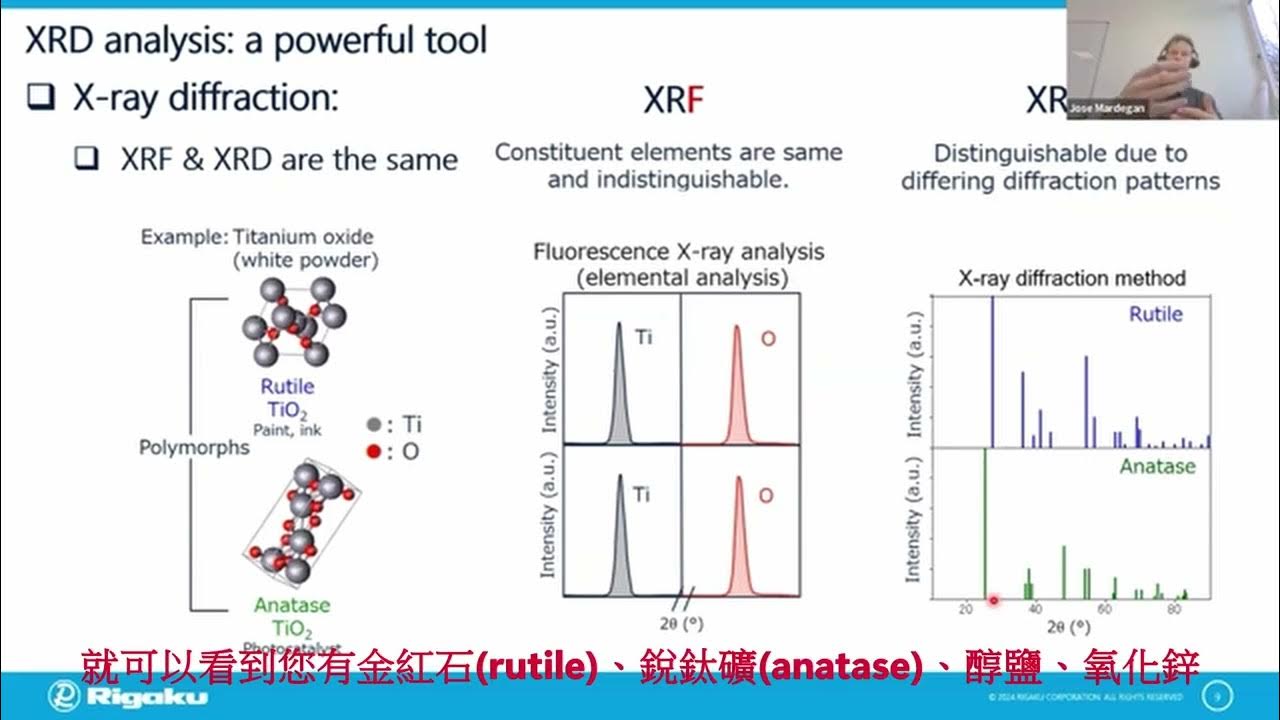What is X-ray Diffraction?
Summary
TLDRX-ray diffraction (XRD) is a powerful technique used to analyze the atomic structure of materials by measuring how X-rays scatter when interacting with crystals. This process reveals crucial details about the arrangement of atoms within a material, using principles like constructive interference and Bragg's Law. XRD is vital in various fields, including material science, pharmaceuticals, and rock analysis, helping scientists develop new materials, understand mineral compositions, and enhance energy storage technologies. With ongoing advancements, XRD continues to be an essential tool for modern research and material engineering.
Takeaways
- 😀 X-ray diffraction (XRD) is a technique used to study the atomic structure of materials by analyzing how X-rays scatter when they interact with the sample.
- 😀 X-rays are high-energy light waves with a wavelength similar to the distance between atoms in a crystal, making diffraction a useful method for studying atomic arrangements.
- 😀 The XRD setup involves placing the sample at the center of the instrument and illuminating it with X-rays, while the X-ray tube and detector move in sync to capture data.
- 😀 Diffraction occurs when X-rays interact with the crystal's atomic planes, resulting in constructive interference at specific angles, leading to the formation of diffraction peaks.
- 😀 Constructive interference happens when the X-ray waves align, amplifying the signal, whereas destructive interference occurs when the waves are out of phase, canceling the signal.
- 😀 The angle between the incident and scattered X-rays, known as 2-theta, plays a crucial role in the diffraction pattern.
- 😀 Bragg's Law, developed by William Henry and William Lawrence Bragg, is used to calculate the spacing between atomic planes based on the diffraction angle.
- 😀 Bragg's Law equation: nλ = 2d sin(θ), where n is the diffraction order, λ is the X-ray wavelength, d is the distance between atomic planes, and θ is the diffraction angle.
- 😀 X-ray diffraction is widely used in material science, pharmaceuticals, geology, and other fields to analyze crystal structures, classify minerals, and design new materials.
- 😀 XRD is essential for understanding how the arrangement of atoms in materials affects their properties and performance in applications like energy storage.
- 😀 Advances in XRD technology have made the technique easier to use and more powerful, significantly enhancing its role in modern research and material engineering.
Q & A
What is X-ray diffraction?
-X-ray diffraction is a technique used to study the atomic structure of materials by observing the interaction of X-rays with the sample, producing diffraction patterns that provide information about the arrangement of atoms.
How does X-ray diffraction work?
-In an X-ray diffraction experiment, a sample is illuminated with X-rays, and the resulting signal is recorded as the X-rays scatter off the atoms in the material. The diffraction pattern formed helps in analyzing the atomic structure.
What role do atomic crystals play in X-ray diffraction?
-Most materials are made up of small crystals, each composed of atoms arranged in a regular pattern. X-ray diffraction takes advantage of this arrangement to measure the distances between atoms through diffraction effects.
Why is X-ray diffraction effective for studying atomic structures?
-X-rays have a wavelength that is similar in size to the distance between atoms in a crystal, which allows them to interact with the atoms and produce diffraction patterns that reveal the atomic arrangement.
What is the principle of diffraction in X-ray diffraction?
-Diffraction occurs when X-rays interact with the regularly spaced atoms in a crystal. Constructive interference amplifies the signal when waves are aligned, while destructive interference cancels out the signal when they are out of alignment.
What is constructive interference?
-Constructive interference happens when two waves align in phase, resulting in the amplification of the signal.
What is destructive interference?
-Destructive interference occurs when two waves are out of phase, canceling each other out and eliminating the signal.
What is Bragg's Law?
-Bragg's Law relates the angle of diffraction to the spacing between atomic planes in a crystal. It is used to calculate the distance between atoms based on the diffraction angle and wavelength of the X-ray.
How does the diffraction angle relate to the atomic structure?
-The diffraction angle determines how the X-rays interact with the atomic planes. A specific angle of diffraction, where constructive interference occurs, can be used to calculate the spacing between atoms in the crystal.
What are the applications of X-ray diffraction?
-X-ray diffraction is used in various fields, such as pharmaceutical development, mineral classification, energy storage research, and material engineering, to analyze and design materials at the atomic level.
Outlines

هذا القسم متوفر فقط للمشتركين. يرجى الترقية للوصول إلى هذه الميزة.
قم بالترقية الآنMindmap

هذا القسم متوفر فقط للمشتركين. يرجى الترقية للوصول إلى هذه الميزة.
قم بالترقية الآنKeywords

هذا القسم متوفر فقط للمشتركين. يرجى الترقية للوصول إلى هذه الميزة.
قم بالترقية الآنHighlights

هذا القسم متوفر فقط للمشتركين. يرجى الترقية للوصول إلى هذه الميزة.
قم بالترقية الآنTranscripts

هذا القسم متوفر فقط للمشتركين. يرجى الترقية للوصول إلى هذه الميزة.
قم بالترقية الآنتصفح المزيد من مقاطع الفيديو ذات الصلة

Prinsip Kerja XRD (X-Ray Diffraction) | Hukum Bragg | Bahasa Indonesia

X ray crystallography basics explained | x ray diffraction

Webinar 2

UAD - Kuliah Online 1475530 Karakterisasi Material Lanjut (Lecture 1b)

UAD - Kuliah Online 1475530 Karakterisasi Material Lanjut (Lecture 1c)

Constructing an Ewald Sphere
5.0 / 5 (0 votes)
